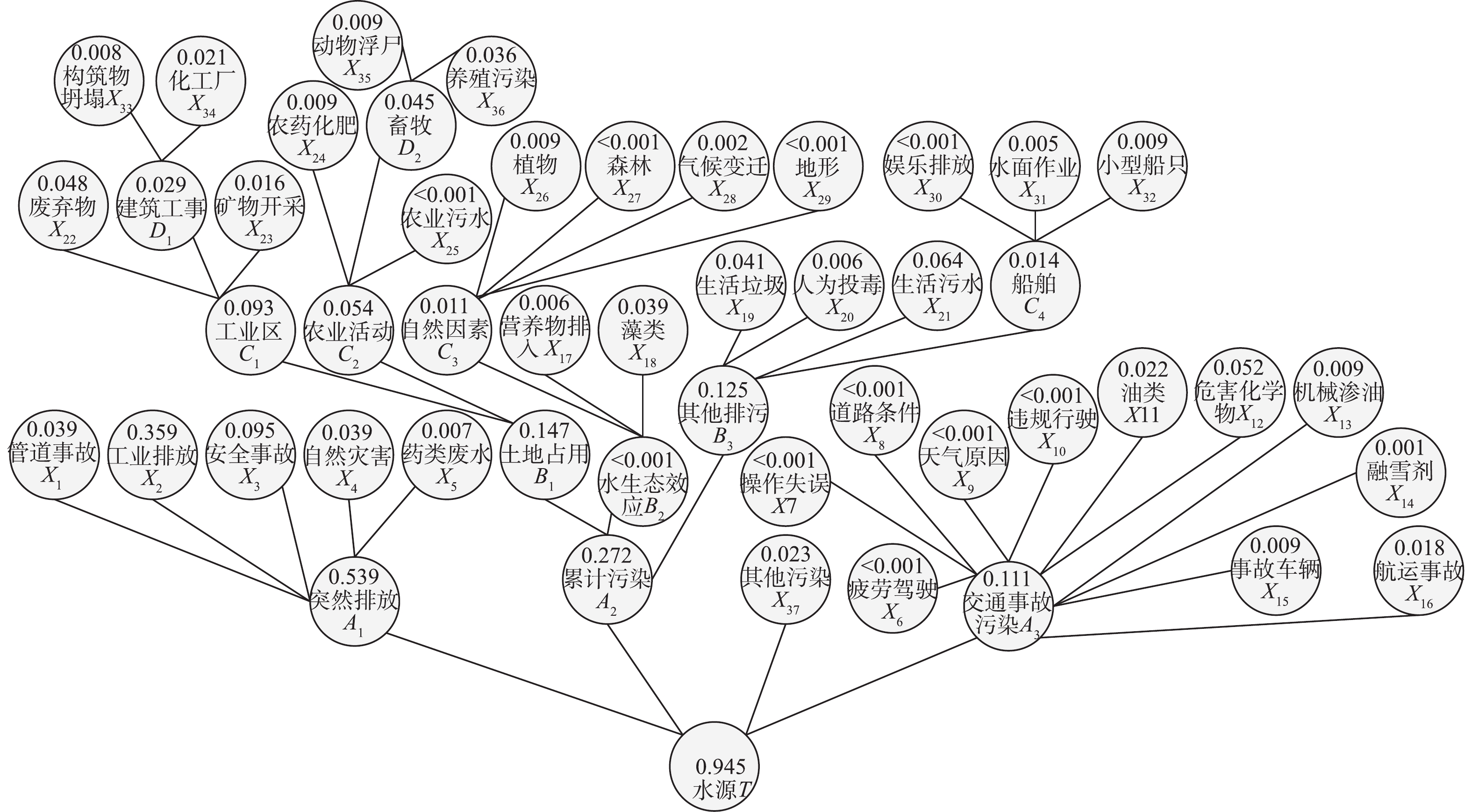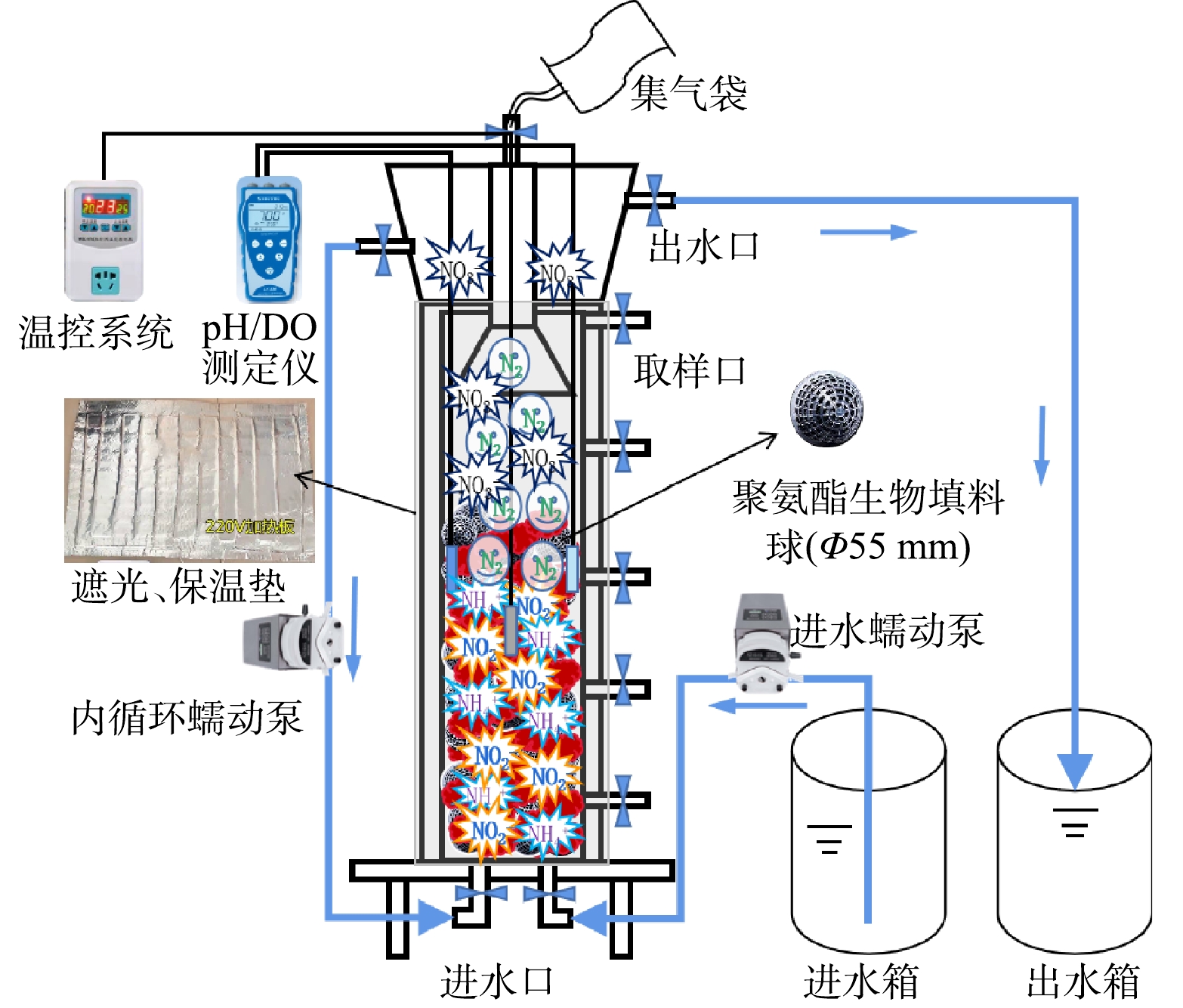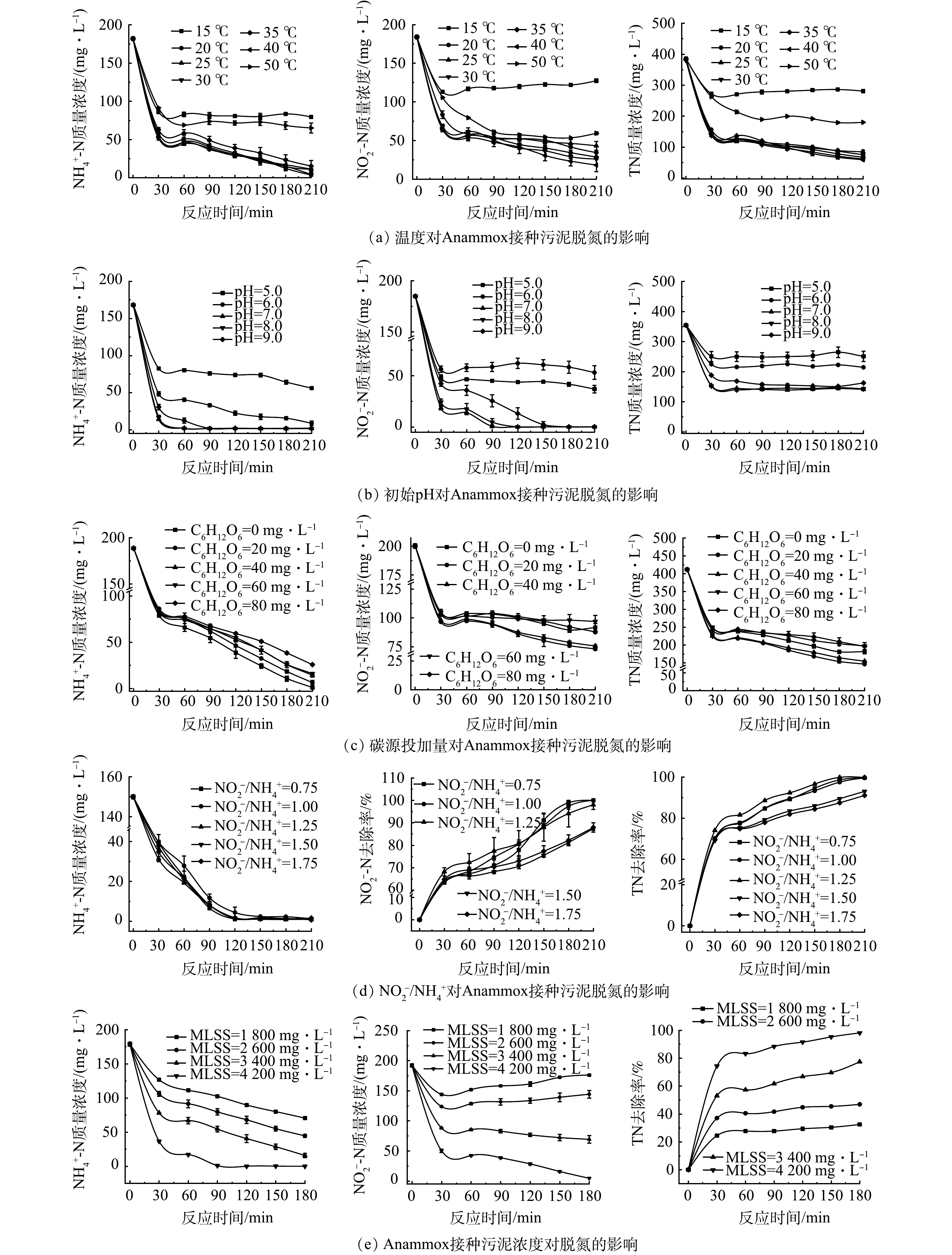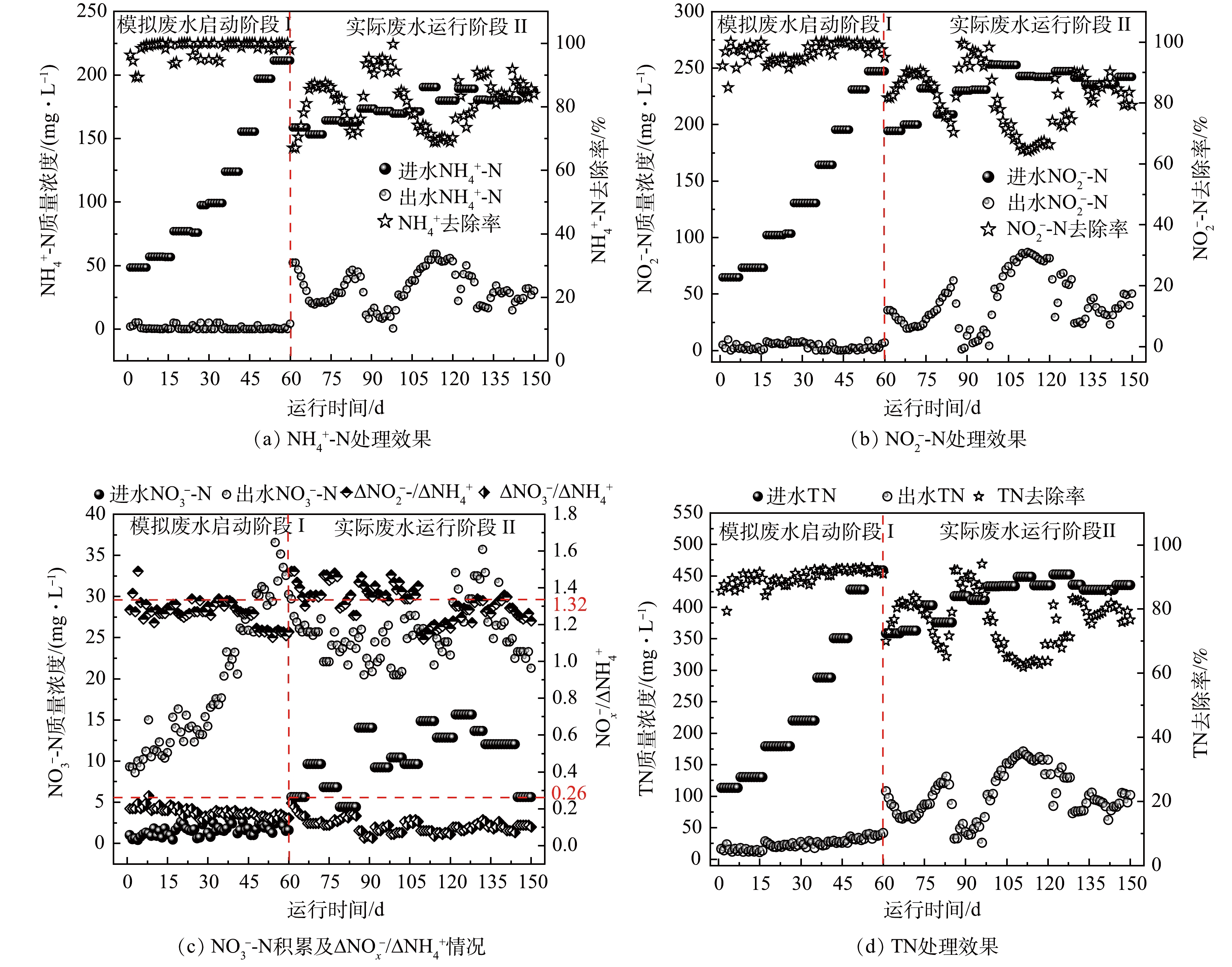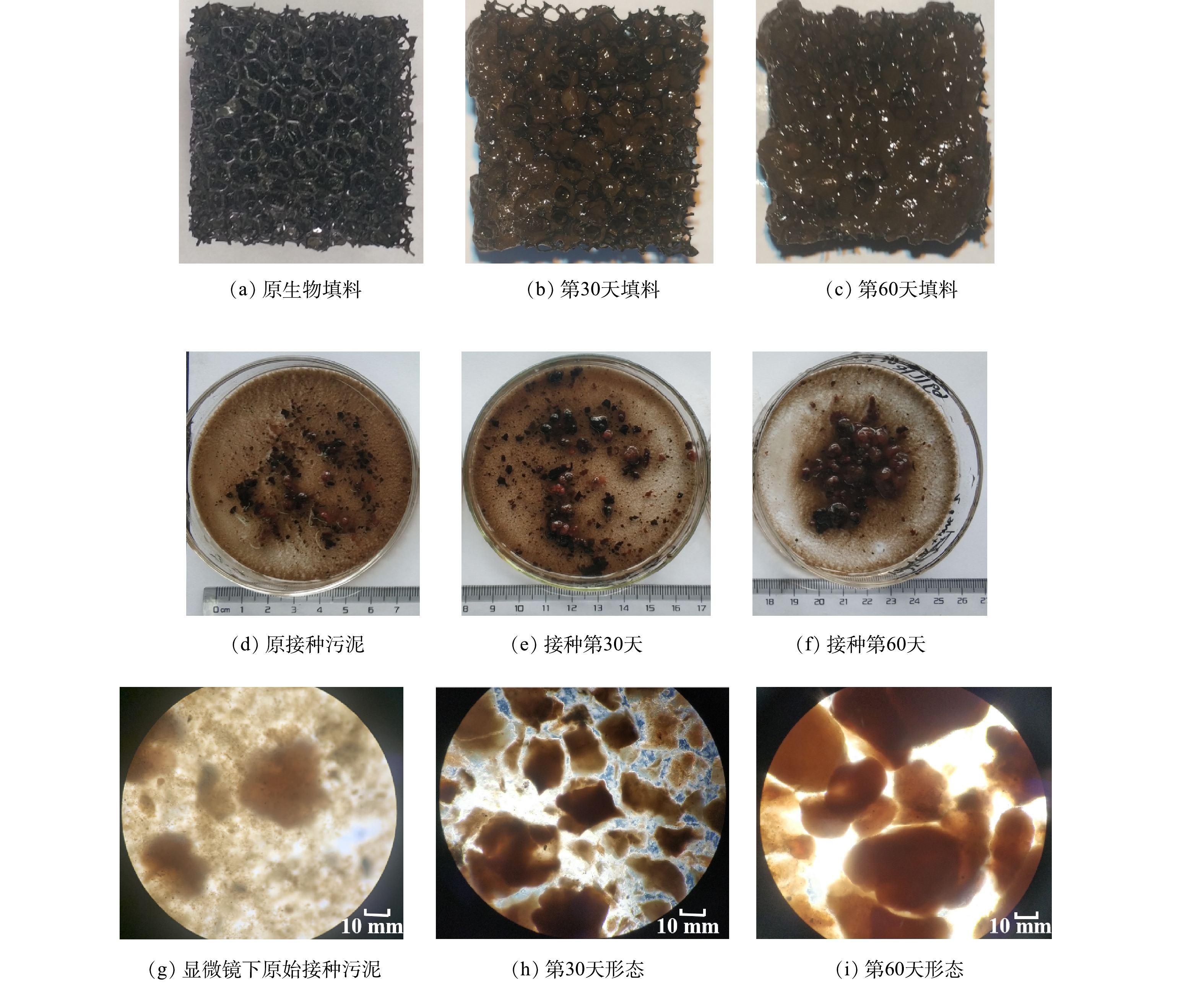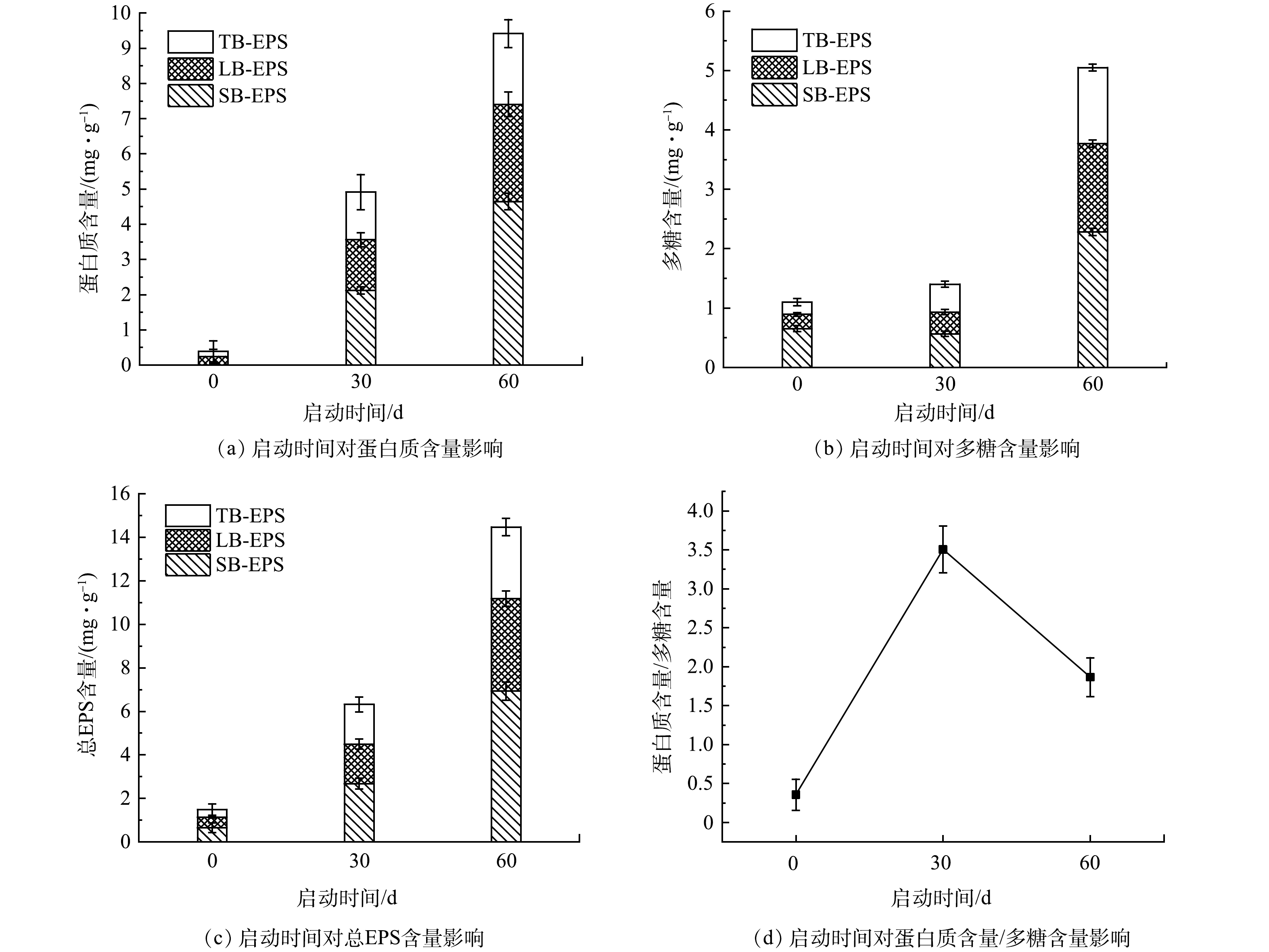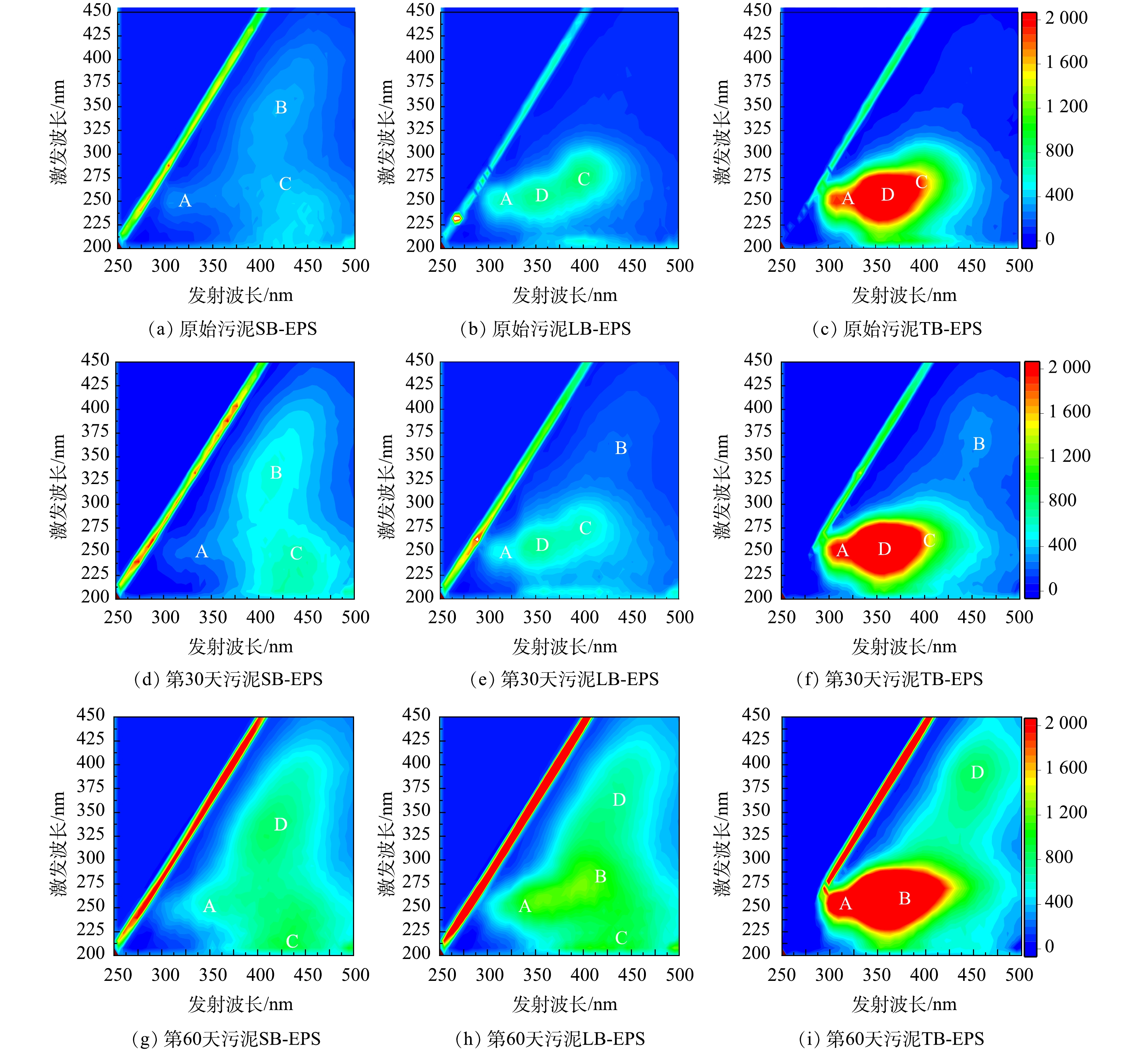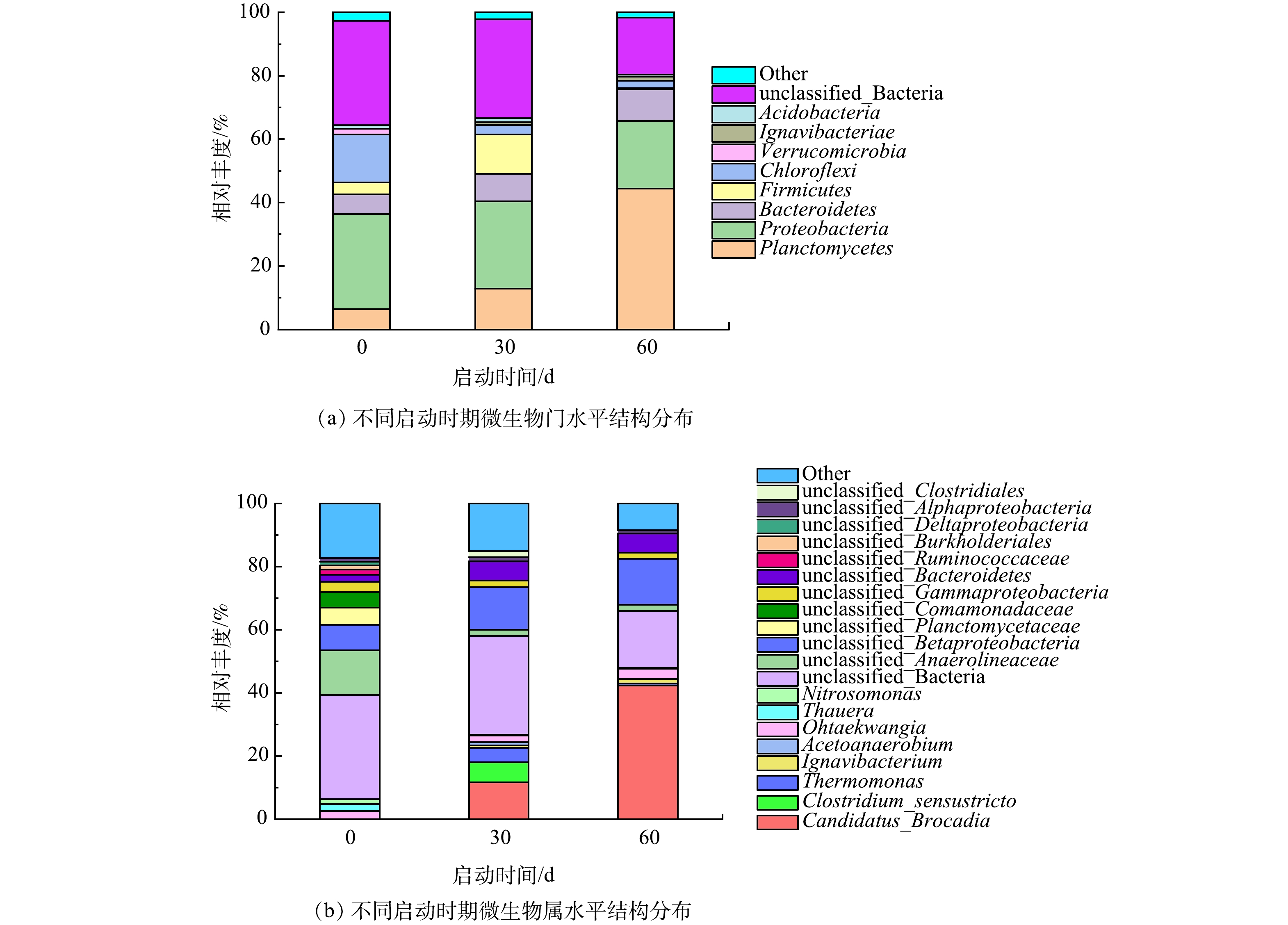-
在我国21世纪初,城市生活垃圾普遍采用填埋的方式进行处置[1],据2021年中华人民共和国统计局报告显示,截至2020年,我国卫生填埋场共644座。填埋场中的生活垃圾随着时间的推移,趋于稳定并产生大量的老龄垃圾渗滤液。与新鲜垃圾渗滤液相比,老龄垃圾渗滤液具有高氨氮、低C/N、可生化性差和污染物成分更加复杂且毒性强等特点[2-3]。
传统脱氮工艺由于存在能耗和运行成本高的缺点。因此,对于低C/N比和高氨氮的老龄垃圾渗滤液而言,目前亟需探究一种经济且高效的脱氮方法。厌氧氨氧化(anaerobic ammonium oxidation, Anammox)是一种新型高效的生物脱氮技术,与传统脱氮技术相比,该技术具备无需曝气、无需外加碳源、污泥产量少、温室气体排放少和运行成本低等优点。该技术是利用厌氧氨氧化菌(anaerobic ammonium oxidation bacteria, AnAOB)在缺氧或者厌氧环境条件下,利用NO2−-N为电子受体,以NH4+-N为电子供体,最后将两者转化成N2的过程[4-5]。目前由于AnAOB生长速度缓慢,且倍增周期较长,导致Anammox工艺在工程运用中存在启动时间长,AnAOB富集丰度低等难题。目前报道文献中,王朝朝等[6]利用Anammox絮状污泥和厌氧颗粒污泥在UASB反应器中经过140 d成功培养出Anammox颗粒污泥,TN去除负荷为0.26 kg·(m3·d)−1;季军远等[7]以絮状厌氧消化污泥为接种污泥,经过250 d成功启动有效体积为1.4 L的Anammox-UASBA反应器;Wang等[8]将Anammox颗粒污泥接种于UASB反应器,经过178 d启动及稳定运行,NLR高达8.25 kg·(m3·d)−1;李亦舒等[9]探究低DO条件下对Anammox工艺脱氮影响,富集的AnAOB丰度仅为14.3%。
基于此,本研究针对短程硝化处理后的老龄垃圾渗滤液,采用UASB反应器快速启动Anammox用于进一步深度脱氮,分析启动过程中接种污泥形貌变化、微生物群落结构变化和脱氮性能。为此,探究Anammox最佳启动条件,并采用厌氧硝化污泥为接种污泥,在30 L的UASB反应器中,仅用60 d成功启动Anammox。启动成功后以短程硝化处理后的老龄垃圾渗滤液为进水,探究该系统脱氮性能。实现Anammox反应器稳定运行和较强的脱氮性能,为其在老龄垃圾渗滤液工程运用中提供科学的技术参考。
-
本研究单因素批量实验采用4至6个用锡箔纸包裹的250 mL的具塞锥形瓶,Anammox启动和实际废水脱氮实验在UASB反应器中进行,实验装置如图1所示。该反应器内径为20 cm,高100 cm,有效体积为30 L,反应器内投加Φ=55 mm的聚氨酯生物填料球,投加量为30%。运行工况:利用温控系统将反应器内温度控制在(30±1) ℃,DO为0.3 mg·L−1,初始pH为7.5,MLSS为4 200~4 500 mg·L−1;模拟废水启动阶段Ⅰ,采用人工配水,设置进水蠕动泵流量为10 L·d−1,利用进水蠕动泵将模拟废水从反应器底部输入,内循环蠕动泵转速设置为2 r·min−1,处理后的水从顶部出水口排入出水箱中;实际废水运行阶段Ⅱ,启动成功后,通过逐渐提高老龄垃圾渗滤液的浓度,运行工况与启动阶段一致。
-
本研究启动阶段采用模拟的垃圾渗滤液为进水,启动成功后以短程硝化处理后的老龄垃圾渗滤液为进水。模拟废水中NH4+-N和NO2−-N由(NH4)2SO4和NaNO2按需添加,其质量浓度分别为50~200 mg·L−1和60~260 mg·L−1。其他主要成分:MgSO4·7H2O、CaCl2、NaHCO3和KH2PO4、微量元素Ⅰ(1 mg·L−1)和微量元素Ⅱ(1 mg·L−1) [10]。
-
本研究接种污泥为广东省云浮市某养鸭废水处理站两级A/O工艺中厌氧硝化污泥,颜色呈棕红色,MLSS为5 000~6 000 mg·L−1。利用缓冲溶液将厌氧接种污泥清洗3遍,随后采用100目筛网进行筛分,去除杂物,并收集筛网上的颗粒污泥;将颗粒污泥置于装有NH4+和NO2−质量浓度分别为30 mg·L−1和40 mg·L−1的密闭容器中,并添加适量的MgSO4·7H2O、CaCl2、NaHCO3和KH2PO4营养物质、微量元素Ⅰ和微量元素Ⅱ进行纯化培养。纯化培养后的接种污泥中微生物数量为3×108个·mL−1,主要微生物群落包括Proteobacteria、Chloroflexi和Planctomycetes。将纯化后的接种污泥避光储存于实验室4 ℃冰箱中。
-
水质根据《水和废水监测分析方法》(第四版)[11]中的方法测定。其中NH4+-N采用纳氏试剂分光光度法测定、NO2−-N采用N-(1-萘基)-乙二胺光度法测定、NO3−-N采用紫外分光光度法、MLSS采用重量法测定、pH和DO采用便携式水质多参数测定仪(上海SANXIN-SX825)测定。
污泥外貌形态,将样品置于10 mL离心管内,加入2.5%戊二醛固定液进行固定,冷冻干燥好后,将样品镀膜后在扫描电子显微镜(SEM,Zeiss Gemini 300,上海卡尔蔡司)进行观察并拍摄。污泥中EPS特征,采用一种改良的热提法提取污泥的3层EPS[12-13],并用三维激发发射矩阵(3D-EEM)荧光光谱法测定EPS中有机物变化。采用考马斯亮蓝法和蒽酮—硫酸法分别测定EPS中的多糖和蛋白质[14-15]。
微生物群落多样性,利用Qubit3.0 DNA检测试剂盒对基因组DNA进行定量。对细菌的16S rRNA的V3~V4区,用通用引物341F(CCTACGGGNGGCWGCAG)和805R(GACTACHVGGGTATCTAATCC)进行PCR扩增,最后采用Illumina MiSeq测序平台完成测序。
-
1)温度对厌氧氨氧化污泥脱氮的影响。有研究[16-17]表明,AnAOB最适的生长温度在15~40 ℃。基于此,探究温度(15、20、25、30、35、40和50 ℃)对Anammox污泥脱氮性能的影响,结果如图2(a)所示。当反应温度为15 ℃和50 ℃时,NH4+-N和NO2−-N的平均去除率分别为56.3%、64.3%和30.8%、67.8%。这是由于低温条件下导致比氨活性(SAA)降低,高温条件下由于细菌细胞裂解,SAA受到抑制[18-20],导致脱氮效率下降[21-22],在20、25、30、35和40 ℃下,NH4+-N和NO2−-N的平均去除率分别超过90%和76%。其中30 ℃下的NH4+-N和NO2−-N去除效果最佳,其平均去除率分别超过98%和85%。当反应温度为30 ℃和40 ℃时,TN的去除率最高,平均值分别为91.7%和91.9%。为节省能耗,将最佳反应温度设为(30±1) ℃。
2)初始pH对厌氧氨氧化污泥脱氮的影响。AnAOB的生理pH为6.7~8.3[23]。不同初始pH(5.0、6.0、7.0、8.0和9.0)对Anammox污泥脱氮性能的影响如图2(b)所示。初始pH的升高,有利于去除NH4+-N、NO2−-N和TN,当初始pH为7.09.0时,NH4+-N、NO2−-N和TN的去除效果最佳,其平均去除率均超过99%。pH决定了游离氨(free Ammonia, FA)和游离亚硝氨(free nitrogenous ammonia, FNA)的浓度,FA已被证明是Anammox系统中的一种重要抑制剂,低pH会导致FA浓度下降,这有利于AnAOB的活动[24]。然而,有研究表明,Anammox主要受pH影响,而非FA的抑制[25]。极端pH可能会影响质子转移和其他代谢过程 [26]。AnAOB菌在酸性条件下受到抑制,从而降低其脱氮性能。结果表明,进水初始pH为7.0~8.0脱氮效果最佳,故本研究将最佳初始pH设为7.5。
3)碳源投加量对厌氧氨氧化污泥脱氮影响。有机物被认为是影响Anammox脱氮性能的一个重要因素[27]。不同C6H12O6投加量(0、20、40、60和80 mg·L−1)对Anammox脱氮性能的影响结果如图2(c)所示。NH4+-N的去除效果与C6H12O6投加量呈负相关,当C6H12O6投加量为0 mg·L−1和20 mg·L−1时,NH4+-N去除效果最佳,其平均去除率分别为99.5%和96.7%;当C6H12O6投加量为80 mg·L−1时,NH4+-N平均去除率仅为86.4%。其主要原因可能是存在有机碳,异养菌会大量生长繁殖[28],如反硝化菌,导致AnAOB菌的生长受到抑制,NH4+-N的去除性能下降。相反,NO2−-N去除率与碳源投加量呈正相关,在C6H12O6低投加量(0 mg·L−1和20 mg·L−1)时,其平均去除率仅为54.3%和65.5%。这主要是因为部分NO2−-N在反硝化菌的作用下转化为N2。有研究表明,在COD为100 mg·L−1时,NH4+-N和TN的去除效率均超过90%相比之下,当COD达到约300 mg·L−1时,Anammox仅占TN去除率的69%[29]。在不同C6H12O6投加量(0、20、40、60和80 mg·L−1)下,TN平均去除率分别为74.0%、80.6%、76.6%、70.3%和81.8%。尽管有机物可能会对Anammox产生不利影响,但较低的有机物浓度或合适COD/N可能会支持Anammox和反硝化的共存[30-32]。从NH4+-N、TN的去除效果以及经济考虑,本研究将不外加碳源。
4) NO2−/NH4+对厌氧氨氧化污泥脱氮影响。研究[23]表明AnAOB对铵和亚硝酸盐的亲和常数均小于或等于0.1 mg N·L−1。探究不同NO2−/NH4+(0.75、1.00、1.25、1.50和1.75)对Anammox污泥脱氮性能影响结果如图2(d)所示。NO2−/NH4+比为0.75、1.00、1.25、1.50和1.75对NH4+-N的平均去除率分别为99.4%、99.1%、99.3%、99.5%和98.9%,对NO2−-N的平均去除率分别为100%、100%、98%、87%和88%,对TN的平均去除率分别为99.6%、99.5%、99.7%、93.0%和91.0%。高底物浓度可抑制Anammox活性,尤其是在高NO2−-N浓度[33]。Anammox反应过程如化学式 (1) 所示[34]。理论上每消耗1 mol NH4+,需要1.32 mol NO2−,若NO2−/NH4+高于1.32理论值,则出现NO2−无法完全反应,导致出水存有剩余的NO2−。若NO2−/NH4+低于1.32,反而会出现NH4+过剩,导致出水TN去除率下降。结果表明,NO2−/NH4+太高或太低都会影响其脱氮性能,故本实验将NO2−/NH4+设为1.25~1.50较为合适。
5)接种污泥浓度对厌氧氨氧化污泥脱氮影响。Anammox脱氮性能与接种污泥浓度相关联[35]。基于此,探究不同接种污泥浓度(1 800、2 600、3 400和4 200 mg·L−1)对Anammox污泥脱氮性能影响,结果如图2(e)所示。污泥质量浓度为1 800、2 600、3 400和4 200 mg·L−1,进水NH4+-N质量浓度控制为153.8 mg·L−1,出水质量浓度分别为70.5、44.6、15.8和0 mg·L−1,其平均去除率分别为54.2%、71.0%、89.7%和100%;NO2−-N进水质量浓度为192.3 mg·L−1,出水质量浓度分别为176.2、144.3、69.3和4.6 mg·L−1,平均去除率分别为8.4%、25%、64%和97.6%;TN的去除率分别为32.5%、46.5%、77.5%和98.2%。结果表明,当接种污泥浓度较低时,系统中的微生物含量也随之减小,导致其脱氮效果不佳,而将污泥浓度提高至一定程度,微生物的数量极为丰富,其脱氮性能最佳。结果表明,接种污泥质量浓度为4 200 mg·L−1时,其脱氮效果最佳。
-
单因素批量实验结果表明,Anammox最适的运行条件温度为(30±1) ℃、初始pH为7.5、无外加有机碳源、NO2−/NH4+=1.25~1.50和接种MLSS为4 200 mg·L−1。基于此,进行Anammox启动和脱氮性能研究,其中启动阶段Ⅰ指以模拟废水为进水,用于Anammox的快速启动;实际废水运行阶段Ⅱ是指在启动成功后,以短程硝化处理后的老龄垃圾渗滤液为进水,探究UASB反应器脱氮性能的研究。由图3(a)可见,模拟废水启动阶段Ⅰ中当NH4+-N质量浓度由48.5 mg·L−1逐渐提升至211.3 mg·L−1时,平均去除率为99.2%。此外,当提高氮负荷比时,其NH4+-N去除效率轻微下降,随后回升到较高的水平。这表明反应器中的微生物具备较强的抗冲击负荷能力,启动过程中NH4+-N的出水质量浓度均低于6 mg·L−1。从图3(b)可知,当NO2−-N从初始质量浓度由64.7 mg·L−1逐渐提升至247.1 mg·L−1,反应器对NO2−-N同样保持较高的去除效果,NO2−-N出水质量浓度低于10 mg·L−1,平均去除率为97.2%。由图3(c)可见,NO3−-N的积累量随着NH4+-N和NO2−-N浓度的增加而增加,但始终低于0.26,∆NO2−-N/∆NH4+-N平均值为1.26,略低于理论值1.32。这可能是由于反应器中除了AnAOB外,还存在反硝化菌,使得Anammox过程中产生的NO3−-N在反硝化菌的部分反硝化作用下转为NO2−-N,导致∆NO2−-N和∆NO3−-N偏低,从而导致结果比理论值低[34]。由图3(d)可见,当TN的质量浓度由113.1 mg·L−1逐渐升至458.4 mg·L−1时,平均去除率为90%,出水质量浓度低于25 mg·L−1,表明第60天时Anammox成功启动。
实际废水运行阶段Ⅱ:启动成功后以短程硝化处理后的老龄垃圾渗滤液为原水,进水NH4+-N、NO2−-N、NO3−-N和TN的质量浓度分别为150~190、200~250、5~15和375~465 mg·L−1。由于水质与启动期的模拟废水存在差异,微生物受到抑制,导致启动初期的脱氮性能不稳定,运行至第125天时,NH4+-N、NO2−-N和TN的平均去除率分别为81.7%、81.9%和76.2%,平均出水质量浓度分别为31、42.5和99.8 mg·L−1,NO3−-N的平均出水质量浓度为25.7 mg·L−1。结果表明,随着运行时间推移脱氮性能趋向稳定,系统运行至126~150 d时NH4+-N、NO2−-N和TN出水较为稳定且保持较高的脱氮效果,其平均去除率分别为86.9%、85.7%和80.2%,表明该系统运行趋向于稳定。
-
1)生物填料以及接种污泥变化。在图4(a)~(c)中观察到聚氨酯生物填料上的孔隙中附着很多由微生物聚集而成生物膜。这说明聚氨酯生物填料可为AnAOB提供附着场所,可以有效解决运行过程中种泥流失的难题。在图4(d)~(f)中观察到絮状污泥逐渐减少,颗粒污泥逐渐增多。为了更清楚地观察污泥形态,利用显微镜进行观察,在图4(g)~(i)中观察到原始接种污泥中絮状污泥居多,只有少数的颗粒污泥,且颗粒污泥粒径较小,第60 天时,可以明显的观察到颗粒污泥占主导地位,同时污泥颗粒化程度高且形态完整。
2)接种污泥表观形貌。为更好地揭示接种污泥颗粒化过程,从UASB反应器中取第0、20、40和60天的污泥样品,观察污泥从开始接种至接种至60 d过程中微生物聚集的情况。由图5(a)可见,原始接种污泥呈现出网状结构,主要是由变形菌门和绿弯菌门形成[36],这为后期AnAOB的富集提供附着位点。由图5(b)可见,第20天的接种污泥在原本树状结构上聚集了球状颗粒。如图5(c)所示,在第40天的接种污泥表面观察到不规则的花椰菜外观。由图5(d)可见,接种60 d后污泥呈现的花椰菜外观更加明显,花椰菜外观是AnAOB成功富集的特征[37]。这表明反应器在40~60 d内AnAOB成功富集。此外,可观察到细菌被某种分泌物紧密连接,这有利于AnAOB抗冲击负荷和具有较好的沉降性能,可有效地减少接种污泥的流失。
3)接种污泥EPS中蛋白质(PN)和多糖(PS)的变化。EPS是污泥颗粒化的重要物质[38]。基于此,本文探究EPS中PN和PS对Anammox颗粒化的影响。由图6(a)可见,原始接种污泥中PN的含量为0.39 mg·g−1(以每克MLVSS计),接种至第30天时,提高至4.92 mg·g−1,接种至第60天时,提高至9.42 mg·g−1。而PN含氨基,并带正电荷,导致污泥表面负电荷减少,微生物间的静电斥力降低,细胞表面的疏水性增强,从而使细胞更易于从水相中脱离出来并互相聚集。因此,PN含量的增加可促进污泥颗粒化[39],表明微生物随着时间推移不断富集,这与SEM的结果一致。接种60 d后,原始接种污泥EPS中PS也由1.10 mg·g−1增加至5.05 mg·g−1,与PN呈现出相同的变化趋势(图6(b))。并且在氮负荷增加的过程中不断分泌更多的EPS,PS通过形成聚合物来促进微生物间的黏附以增强颗粒污泥的稳定性。同时,PS交联形成的水凝胶是维持颗粒污泥稳定的重要因素[40]。PS长主链之间的缠结以及丰富的结合位点桥接形成骨架,增强了微生物之间的黏附,有利于维持颗粒污泥的稳定状态[41]。PN/PS通常可以作为接种污泥稳定性和沉降性能的表征,由图6(d)可知,原始接种污泥PN/PS为0.356,第30天时其值为3.51,第60天时其值为1.87。有研究[42]表明,PN/PS为0.5~5内时,颗粒污泥的稳定性和沉降性随该比值增大而增强。由图6(c)和图6(d)可知,总EPS的分泌量的增加表明AnAOB得以富集。
4)污泥EPS的3D-EEM结果。AnAOB分泌特定的EPS,可间接表征AnAOB的生长富集状况[43]。基于此,本文研究不同运行时期接种污泥各层EPS荧光光谱的变化,结果如图7所示。EPS的荧光谱图中主要包含4个特征峰:A峰激发波长/发射波长(Ex/Em)位于230~260 nm/300~330 nm,为酪氨酸蛋白;B峰Ex/Em位于337~400 nm/425~462 nm,为腐殖酸;C峰Ex/Em位于260~280 nm/370~425 nm,为富里酸和D峰Ex/Em位于230~262 nm/335~370 nm,为色氨酸蛋白质[44]。与图7(a)和图7(b)的接种污泥相比较,第30天(图7(e)~(f))和第60天(图7(h)~(i))在LB-EPS和TB-EPS层出现了腐殖酸类有机物 (B峰) ,该有机物是AnAOB中的Candidatus Brocadia分泌的特定物质[45],表明第30天和60天之后AnAOB得到富集,且第60天时富集程度比第30天时要高。接种第60天的酪氨酸蛋白质(峰A)和色氨酸蛋白质(峰D)荧光强度比接种污泥高,且这2种物质在Anammox污泥的聚集中起重要作用[44]。表明随着污泥接种时间的推移,微生物不断的分泌出更多的胞外聚合物,同时也说明微生物不断的进行生长繁殖,与上节的扫描电镜的结果相一致。
-
1)微生物多样性分析。采用16S rRNA高通量测序技术分析接种污泥在UASB反应器运行过程中微生物群落结构变化情况。由表1可知,覆盖率(coverage)均大于99%。0~30 d反应器中氮负荷由0.075 kg·(m3·d)−1提升至0.153 kg·(m3·d)−1,OTUs数由370降至322,微生物多样性和丰度均呈现较明显的下降趋势,说明大部分不适应环境的微生物被淘汰。30~60 d反应器中氮负荷增加至0.306 kg·(m3·d)−1,OTUs数由322降至312,微生物多样性和丰度呈现出略微下降趋势,表明微生物逐渐适应环境。此外,Simpson指数增大,Shannon指数、Ace指数和Chao1指数有所降低。以上结果表明,随着氮负荷的增加,微生物群落多样性和丰度与原始接种污泥相比有所下降,表明在运行过程中系统不断将不适应环境的微生物进行淘汰,从而使得主要的功能菌逐渐占据主导地位,从而提高系统的脱氮性能。
2)门水平物种丰度分析。图8(a)反映了UASB反应器接种第0、30和60天时在门水平上微生物群落结构。结果表明:第0天时,反应器内门水平的微生物主要包括变形菌门(Proteobacteria)、绿弯菌门(Chloroflexi)、浮霉菌门(Planctomycetes)、拟杆菌门(Bacteroidota)、厚壁菌门(Firmicutes)、疣微菌门(Verrucomicrobia)和酸杆菌门(Acidobacteria),其相对丰度分别为29.9%、15.2%、6.40%、6.22%、3.76%、1.77%和1.15%;第30天时,反应器中浮霉菌门、拟杆菌门、厚壁菌门和酸杆菌门的相对丰度分别提高至12.9%、8.72%、12.7%和1.32%,变形菌门和绿弯菌门分别下降至27.5%和3.05%,在第30天时没有检测到疣微菌门,却检测到Ignavibacteriae,其相对丰度为0.81%;第60天时,浮霉菌门、拟杆菌门和Ignavibacteriae相对丰度分别提高至44.4%、9.95%和1.34%,变形菌门、厚壁菌门、绿弯菌门和拟杆菌门相对丰度分别降至21.4%、0.36%、2.32%和0.54%。有研究表明,Anammox体系中AnAOB可与上述微生物存在共存现象[46-47]。
反应器运行至第60天时,浮霉菌门成为第一优势菌门,这主要是启动时逐渐提升氮负荷,且无外加有机碳源,使得接种污泥中的变形菌逐渐地失去第一优势菌的地位。而AnAOB为化能自养型细菌,在无有机碳源的环境中更有利其生长繁殖,从而使其在系统中更加具有竞争力。虽然变形菌门失去了第一优势菌门的地位,但其依旧保持较高的丰度,该菌门中含硝化、反硝化细菌,提升反应体系中的脱氮效率。值得注意的是,Ignavibacteriae从未检出到第60天时升至1.34%,该菌属于异养兼性厌氧菌,能将NO3−-N还原为NO2−-N[46],有利提高系统的脱氮性能,同时可解释Anammox的系统中∆NO2−/∆NH4+和∆NO3−/∆NH4+低于理论值的原因。大部分的丝状菌为绿弯菌门,由于接种污泥中绿弯菌门为第二优势菌门,为后期AnAOB的富集提供附着位点,此外该菌门还参与凋亡细胞的分解和胞外物质的合成[36]。Anammox反应器是一个多种微生物共存的系统,形菌门、厚壁门、绿弯菌门和拟杆菌门等微生物参与脱氮,有利于反应器脱氮和稳定运行。
3)属水平菌群结构分析。在UASB反应器接种第0、30和60天时,属水平上的微生物群落结构变化如图8(b)所示。接种污泥主要以Thauera、Thermomonas、Nitrosomonas、Ohtaekwangia为优势菌。运行60 d后,浮霉菌门中的Candidatus Brocadia成为优势菌,其丰度从反应器启动前未检出提高至42.4%。通常,随着低氮负荷向高氮负荷的提升过程中Candidatus Brocadia可能受高浓度NO2−-N的抑制[48]。但本研究中Candidatus Brocadia可以免受抑制且成为优势菌,表明Anammox启动成功。
同时反应器存在Thauera、Thermomonas、Nitrosomonas、Ohtaekwangia和Ignavibacterium等硝化反硝化菌,Thauera的存在有利于COD和TN的去除[47],Thermomonas属于热单胞菌,可以有效去除NO3−-N[49];Nitrosomonas属于AOB菌,该菌利用一部分NH4+-N转化成NO2−-N为AnAOB提供基质;Ohtaekwangia属于硝化细菌门,其丰度由初始2.60%增加至3.32%,该菌丰度增加有利于系统的脱氮[50],Ignavibacterium属于亚硝化盐还原菌,该菌丰度增加至1.34%,在Anammox系统中经常与AnAOB发挥作用。虽然前3者的丰度有所下降,后两者的丰度上升,但其对该反应器高效脱氮有重要贡献
-
1)在UASB反应器中成功快速启动Anammox,其最佳运行条件为(30±1) ℃、初始pH为7.5、无需外加碳源、NO2−-N/NH4+-N为1.25~1.50和MLSS为4 200 mg·L−1,历经60 d快速启动成功厌氧氨氧化。
2) UASB反应器启动60 d后,污泥中EPS中PN由0.39 mg·g−1增至9.42 mg·g−1,PS从1.1 mg·g−1增加至5.05 mg·g−1,总EPS由接种前的1.49 mg·g−1增至14.5 mg·g−1,说明氮负荷增加时有利于微生物分泌出更多的胞外聚合物,有利于Anammox颗粒的形成,增强其抗负荷能力,且能减少种泥流失。
3)启动成功的UASB反应器处理老龄垃圾渗滤液,系统运行至126~150 d时NH4+-N、NO2−-N和TN平均去除率均在80%以上,TN去除负荷最高为0.36 kg·(m3·d)−1,可为工程规模的Anammox快速启动用于老龄垃圾渗滤液脱氮提供参考。
4) UASB反应器启动成功后,微生物多样性减少,AnAOB所在的浮霉菌门(Planctomycetes)成为优势菌门,其相对丰度为44.4%,Candidatus Brocadia成为优势菌属,相对丰度提高至42.4%,说明AnAOB成功富集,AnAOB利用NO2−-N为电子受体,以NH4+-N为电子供体实现深度脱氮。同时UASB反应器是一个以硝化反硝化菌为辅,以AnAOB为主的共生系统。
快速启动厌氧氨氧化用于老龄垃圾渗滤液脱氮及其机理分析
Nitrogen removal from mature landfill leachate and its mechanism by using fast start-up of anaerobic ammonia oxidation
-
摘要: 基于短程硝化处理后的老龄垃圾渗滤液,含有大量难降解有机污染物,且氨氮和化学需氧量浓度高,C/N比低等特点。本研究以厌氧硝化污泥作为接种污泥,采用升流式厌氧污泥床反应器(UASB),快速启动厌氧氨氧化反应,对其进行深度脱氮。探究启动厌氧氨氧化反应的最佳条件和脱氮性能,根据污泥形貌特征和微生物群落结构的变化,阐明厌氧氨氧化的作用机理。结果表明,厌氧氨氧化快速启动最佳条件:温度为(30±1) ℃、初始pH为7.5、NO2−/NH4+为1.25~1.50、无外加碳源和MLSS为4 200 mg·L−1。历经60 d后,厌氧氨氧化成功启动,进水TN容积负荷最高为0.45 kg·(m3·d)−1,TN容积负荷去除速率最高为0.36 kg·(m3·d)-1,NH4+-N、NO2−-N和TN去除率超过80%。同时,UASB运行至第60天时,接种污泥形貌呈现花椰菜结构,微生物群落多样性减少,Planctomycetes门为优势菌群,其丰度为44.4%。Candidatus Brocdia属为第一优势菌属,其丰度为42.8%,证实厌氧氨氧化快速启动成功,AnAOB利用NO2−-N为电子受体,以NH4+-N为电子供体实现深度脱氮。综上所述,厌氧氨氧化的快速启动可为短程硝化处理后的老龄垃圾渗滤液深度脱氮提供参考。Abstract: In this study, anaerobic nitrification sludge was used as the inoculated sludge, and the upflow anaerobic sludge bed reactor (UASB) was used to perform the fast start-up of anaerobic ammonia oxidation (Anammox) to further remove nitrogen. Based on the characteristics of mature landfill leachate after short-cut nitrification treatment which contains a large number of refractory organic pollutants, high ammonia nitrogen concentration and chemical oxygen demand, and low C/N ratio. The optimal conditions and denitrification performance for Anammox reaction were explored, and the mechanism of Anammox was also elucidated according to the changes of sludge morphology and microbial community structure. The results showed that the optimal condition for fast start-up of the Anammox process was (30±1) ℃, initial pH=7.5, NO2−/NH4+=1.25~1.50, without external carbon source and MLSS=4 200 mg·L−1, respectively. After 60 days, the successful fast start-up of Anammox occurred, the removal rates of NH4+-N, NO2−-N and TN exceeded 80% when the inlet TN volume load was 0.45 kg·(m3·d)−1 and the TN volume load removal rate was 0.36 kg·(m3·d)-1. The result of scanning electron microscopy (SEM) revealed that the morphology of inoculated sludge exhibited cauliflower structure after 60 days operation of UASB process. Simultaneously, the result of 16S rRNA high-throughput sequencing indicated that the diversity of microbial community decreased after start-up. Planctomycetes phylum was the dominant bacterial community, with an abundance of 44.4%, and Candidatus Brocdia was the dominant genus, with an abundance of 42.8%. Both results of SEM and 16S rRNA confirmed that the fast start-up of Anammox was successful. AnAOB uses NO2−-N as the electron acceptor and NH4+-N as the electron donor for deep denitrification. In conclusion, the fast start-up of process of Anammox provides a reference for the deep nitrogen removal of mature landfill leachate after short-cut nitrification.
-
近些年,我国水污染事故时有发生,威胁到水资源的安全[1-3]。水污染问题不仅影响水生态,还威胁到供水安全,甚至造成社会公共事件。为应对水污染事故,我国构建了相关应急机制,但多针对水污染事故造成的后果以及处理方法。在水污染事故发生后采取的应急及处理方法使得污染物处置难度大,还会增加社会经济成本。如何在事故发生前,建立以风险防控为目标的水源污染突发事件高风险点识别方法,实现有效预警,是当前管理部门所关注的重点之一[4-6]。
对事故敏感点进行诊断通常采用事故树分析(fault tree analysis,FTA)方法,亦称为故障树分析法。这种方法是安全系统工程中常用的研究方法,能帮助找出导致事故发生的基本原因事件[7-9]。目前,该方法已经被成功应用于矿山、能源、石化、交通、公共卫生、电力、和经济等多个行业,但在水源污染事故风险点甄别中的应用还很少[10-12]。事故树分析主要将构成事故因素逐级分解成单独事件,采用布尔代数计算各导致事故的最小割集和径集、结构重要度等为研究方法。然而,对于事故概率的估计往往基于经验值,国内同类研究中缺乏关于大量已发生事故案例的定量统计研究[13-15]。
本研究基于世界卫生组织(World Health Organization,WHO)颁发的《饮用水水质准则》和《水安全计划手册—供水企业分步实施的风险管理》,建立水源事故树的基本事故框架。结合我国2000年以来能够查阅到的1 900多起水源污染突发事件案例,统计计算出各个基本风险因素发生概率。采用事故树分析方法和贝叶斯网络定量分析了导致水源污染的各种事件概率,最终通过事故树节点逻辑关系确定水源水质发生污染事故的不同事故节点发生概率。根据我国近20年发生的事故对所有因素进行了导致水源污染的基本事故排序,筛选出水源高风险点,以期为加强水源安全事故风险管控提供技术参考。
1. 材料与方法
1.1 数据来源
目前,我国尚未建立较大的水源污染突发事件案例数据库,相关部门缺乏详细统计年鉴。根据我国2000—2019年的公开报道资料,本研究收集国内水污染突发事件总计约2 500起。按照污染事件名称、发生时间、发生地点、污染名称、事故原因及水体类别做了统计,选出其中水源(江、河、湖泊、地下水、自备饮用水源)污染事故案例1 900起用于水源地风险甄别研究。
1.2 分析方法
1) 建立水源事故树。参照WHO发的《饮用水水质准则》和水安全计划手册—供水企业分步实施的风险管理方法,结合水源污染事故案例数据,用Visio软件将水源(T)作为顶上事件,突然排污、土地占用、工业区、建筑工事等(A、B、C、D类)作为中间事件,管道事故、企业违规排污、企业安全事故等因素(X类)作为基本事件,根据实际事故之间触发逻辑,建立基本事件造成水源污染的事故树关系图(见图1)。
2) 重要度分析。对水源事故树导出的各类基本因素使用Excel软件整合到水源污染突发事件案例中,应用古典概率模型(式(1))计算基本事件发生的概率。应用基本事件结构重要度(式(2))和基本事件概率重要度(式(3))计算各基本事件的结构重要度和概率重要度并进行排序分析。
3) 风险点甄别。基于1900起统计数据计算出的各基本事件发生概率,通过事故树逻辑门中的乘(“×”)(式(4))或加(“+”)(式(5))计算顶上事件或者中间事件发生的概率,结果见表1。
表 1 水源事故树基本危害事件统计Table 1. Basic hazard event statistics of water source fault tree基本事件 对应代码 发生概率 基本事件 对应代码 发生概率 管道事故 X1 0.039 人为投毒 X20 0.006 企业违法排污 X2 0.359 生活污水 X21 0.064 安全事故 X3 0.095 废弃物 X22 0.048 暴雨、洪水 X4 0.039 矿物开采 X23 0.016 药类废水 X5 0.007 农药化肥 X24 0.009 疲劳驾驶 X6 <0.001 农业污水 X25 <0.001 操作失误 X7 <0.001 水生植物 X26 0.009 道路条件 X8 <0.001 森林 X27 <0.001 天气原因 X9 <0.001 气候变迁 X28 0.002 违规行驶 X10 <0.001 地形 X29 <0.001 油类 X11 0.022 娱乐排放 X30 <0.001 危害化学物 X12 0.052 水面作业 X31 0.005 机械渗油 X13 0.009 小型船只 X32 0.009 融雪剂 X14 0.001 构筑物坍塌 X33 0.008 事故车辆 X15 0.009 化工厂 X34 0.021 航运事故 X16 0.018 动物浮尸 X35 0.009 氮磷营养物 X17 0.006 养殖污染 X36 0.036 藻类 X18 0.039 其他污染 X37 0.023 生活垃圾 X19 0.041 4) 使用贝叶斯网络(Bayes networks, BN)进行验证计算。将事故树中的每个事件映射成贝叶斯网络的节点,事故树中各基本事件发生概率对应到贝叶斯网络中根节点的先验概率,根据事故树中逻辑门的逻辑关系得到贝叶斯网络中对于节点的条件概率[16](见式(6))。
1.3 模型应用
1) 基本事件发生概率。结合全国1 900起饮用水源突发污染事件案例,用Excel软件对基本污染因素发生频次进行了统计,通过古典模型概率公式(式(1))计算水源基本事件危害的概率。
p(A)=K/N (1) 式中:N为样本点总数;K为事件A的样本点个数。
2) 基本事件结构重要度[17]。
Iϕ(i)=1/k∑mj=11/Rj (2) 式中:
k 为事故树包含的最小割集数目;m 为包含第i 个基本事件的最小割集数目;Rj 为包含第i 个基本事件的第j 个最小割集中基本事件的数目。3) 基本事件概率重要度[17]。
Ig(i)=∂g(q)/∂qi (3) 式中:
g(q) 为事故树概率函数;qi 为包含第i 个基本事件的概率函数。4) 与门结构的顶上事件的发生概率计算公式[18]见式(4)。
PT=⋂ni=1Xi=∏ni=1Pi (4) 或门结构的顶上事件的发生概率计算公式[19]见式(5)。
PT=⋃ni=1Xi=1−∏ni=1(1−Pi) (5) 式中:
Xi 为事件变量;PT 和Pi 为顶上事件及其下级事件的概率;n 为使顶上事件发生的下级事件个数;T为顶上事件。下文假设所有下级事件为独立且非互斥事件。5) 贝叶斯网络(BN)是每个节点都带有一张条件概率表的有向无环图。利用联合概率分布得顶事件的发生概率用(式(6))计算。
PT=∏ni=1P(xi/F(xi)) (6) 式中:
xi 为对应于子节点的状态值;F(xi) 为对应于父节点的状态值;n 为BN中节点的数目。2. 结果
2.1 水源基本事件梳理
根据1 900起事件通过古典概率模型(1)估算近20年导致水污染因素的发生概率,结果见表1。
根据实际突发水污染事故案例统计结果,引起我国水源水质风险的基本事件有37类。其中,基本事件风险排序依次主要有:1)工业废水,主要是一些企业违规排放导致的;2)安全事故,主要是针对部分企业设施人为操作不良引发的水质安全事故造成的;3)生活污水、工业废弃物、生活垃圾、藻类、自然灾害,如暴雨、洪水引发的水体污染;4)管道事故,如输油或输送污水管道破裂;5)油类泄漏污染,主要是指交通事故造成的,化工厂占地导致的地下水污染,大型载物船舶航运事故,矿物开采过程中由废水排放和尾矿库渗漏造成的;6)部分植物,如浒苔、水葫芦等蔓延水面生长,造成的水质大面积缺氧状况;7)农药化肥,如河流近地进行农业活动或清洗农药工具;8)小型船只活动、事故车辆、机械渗油、养殖动物浮尸造成的;9)建筑工事坍塌事故、医药废水、氮磷营养物、人为故意破坏,主要是投毒捕鱼事件,水面作业触发的偶然水体污染事故,气候变迁、及清理路面积雪时使用的融雪剂等因素均会对水源水质造成不同程度的影响。
2.2 概率计算
基于事故树可以定量分析某类事故发生的概率。如基于大量的统计数据可以计算各基本事件发生的概率,通过逻辑门中的加(“+”)或乘(“×”)计算顶上事件发生的概率,与预定的目标进行比较。如果得到的结果超过了允许目标,则采取相应的改进措施,使其降至允许值以下,以达到控制事故率处于设定安全阈值之下的目的[20-21]。
根据表1中基本事件的发生概率,按照事故树结构和计算原理,对事故树加以分析。水质污染风险的计算表达式见式(7)。
T=4∑i=1A4=(5∑i=1Xi)+(3∑i=1Bi)+(16∑i=6Xi)+X37=X1+X2+X3+X4+X5+X6+X7+X8+X9+X10+X11+X12+X13+X14+X15+X16+X17X26+X17X27+X17X28+X17X29+X18X26+X18X27+X18X28+X18X29+X19+X20+X21+X22+X23+X24+X25+X33+X34+X35+X36+X37 (7) 根据式(7),获得最小割集为38,即造成水质污染的可能路径有38个。由式(2)得基本事件结构重要度计算见式(8),对水源产生污染风险的结果重要度顺序见式(9)。由式(3)得基本事件概率重要度见式(10),对水源产生污染风险的概率重要度顺序见式(11)。
I1=I2=I3=I4=I5=I6=I7=I8=I9=I10=I11=I12=I13=I14=I15=I16=I19=I20=I21=I22=I23=I24=I25=I26=I27=I28=I29=I33=I37=0.026,I17=I18=0.053 (8) I17=I18>I1=I2=I3=I4=I5=I6=I7=I8=I9=I10=I11=I12=I13=I14=I15=I16=I19=I20=I21=I22=I23=I24=I25=I26=I27=I28=I29=I33=I37 (9) I1=I2=I3=I4=I5=I6=I7=I8=I9=I10=I11=I12=I13=I14=I15=I16=I19=I20=I21=I22=I23=I24=I25=I33=I37=1,I17=I18=0.013,I26=I27=I28=I29=0.045 (10) I1=I2=I3=I4=I5=I6=I7=I8=I9=I10=I11=I12=I13=I14=I15=I16=I19=I20=I21=I22=I23=I24=I25=I33=I37>I26=I27=I28=I29>I17=I18 (11) 独立性事件发生概率模型,根据事故树节点逻辑关系,由式(4)和式(5)计算出中间事件的概率,结果如表2所示。
表 2 水源事故树中间事件结果Table 2. Middle event result list of water source fault tree中间事件 对应代码 发生概率 中间事件 对应代码 发生概率 突然排放 A1 0.466 工业区 C1 0.09 累计污染 A2 0.242 农业活动 C2 0.054 交通事故污染 A3 0.109 自然因素 C3 0.012 土地占用 B1 0.139 船舶 C4 0.014 水生态污染变化 B2 <0.001 建筑工事 D1 0.029 其他排污 B3 0.12 畜牧 D2 0.045 通过计算发现,水源污染风险依次为突然排放、累计污染、交通事故造成的污染。突然排放中,主要以工业废水为主;累计污染中长期对土地占用带来的风险相对较大,其次是其他排污;交通事故造成的污染主要是油类、化学品泄漏水体排放带来的风险。
2.3 结合贝叶斯网络进行验证计算
为提高事故的预测可靠性,采用贝叶斯网络对事故树进行验证计算。考虑到贝叶斯网络和事故树有很大的相似性,而贝叶斯网络还具有描述事件多态性和事故逻辑关系非确定性的能力,因此,将运用事故树结合贝叶斯网络对水源污染风险进行分析。
首先做水源污染事故树到贝叶斯网络的映射,基本事件对应于BN中的根节点,中间事件对应于中间节点,顶事件对应于叶节点,并运用式(6)计算各节点的污染概率,如图2所示。做事故树和贝叶斯网络的事件发生概率结果比较,可以发现计算结果相近,说明计算结果(表3)合理。
表 3 事故树与贝叶斯网络计算结果比较Table 3. Comparison of accident tree and Bayesian network results中间事件 对应代码 发生概率 中间事件 对应代码 发生概率 FTA BN FTA BN 突然排放 A1 0.466 0.539 工业区 C1 0.09 0.093 累计污染 A2 0.242 0.272 农业活动 C2 0.054 0.054 交通事故污染 A3 0.109 0.111 自然因素 C3 0.012 0.011 土地占用 B1 0.139 0.147 船舶 C4 0.014 0.014 水生态污染变化 B2 <0.001 <0.001 建筑工事 D1 0.029 0.029 其他排污 B3 0.12 0.125 畜牧 D2 0.045 0.045 3. 讨论
由以上分析计算结果,可以获得水源污染的类型很多,主要像突发性污染、累积性污染、交通事故等都会对水源造成污染。因此,要有效降低污染风险效应,可从这些基本事件分解入手。
3.1 突发性污染
突发性水污染事件往往没有任何预兆,如管道泄漏、爆炸等都有可能造成水污染事件的爆发[22-24]。根据事故案例统计,我国2000—2019年工业废水造成的污染事件达880多起。引起我国水源水突发性事故污染的直接原因有:企业直接排放工业废水、废水管道事故和企业安全事故、自然灾害等引发的间接工业废水排放。水源上游工业企业数即危险源的数量,与突发水污染事件频数呈正相关[25-27]。结合案例分析可知,工业废水对水源的污染最大,主要原因有:一方面,我国近几年工业发展较快,企业数量增长和产生的工业废水增加,为事故的发生创造了条件;另一方面,近几年我国致力于经济的发展的同时也带来了一定环境方面的问题。大部分生产企业建在河流附近[28-30],案例显示,很多化工企业趁着雨季或暴雨将大量未经处理的废水排入水体的事件时有发生,使水质受到严重污染。因此,雨季往往是高风险时间段。
3.2 累积性污染
1)土地污染。土地的累积性污染主要来自工业区和农业类污染。工业区主要有工业废弃物造成的污染,矿物开采、化工厂以及部分建筑物坍塌事故造成的土地污染;农业活动污染主要是畜牧养殖和农业废弃物等。如遇到暴雨天气,上述累积的污染物极易被大范围释放。
2)水生态污染变化。引发水生态效应的基本因素主要有氮磷营养物、藻类及自然因素如光照等。氮肥和磷肥的施用是作物生产必需的措施。农药、化肥的过量使用使得农田养分超出负荷,氮磷等营养物质在雨水等因素的作用下流入水体,最终造成地表水出现营养物累积[31-32],导致藻类爆发。
3)其他排污。主要指垃圾填埋场和生活污水造成的排污。垃圾填埋场对地下水环境的影响主要来自防渗层出现故障,下渗的渗滤液会导致地下水的水质出现变化[9];生活污水的排放和垃圾倾倒,从而威胁河流水体水质[20-21]。
3.3 交通事故污染
案例统计发现,2003—2019年交通事故引起的水体污染达200起,这必然会对水体产生直接的影响[10]。尤其是船舶交通事故,对航道及附近水体的污染危害较大。交通事故污染中,公路交通事故造成的水体污染,以化学品泄漏排放为主;水上交通以航运事故污染及柴油泄漏排放为重要源。
4. 结语
水源污染产生有很多种原因。基于长期案例累积,并通过事故树进行分析,可以避免以往根据专家主观判断产生的误差,从而得到一个相对科学的结论。该方法能够对导致污染事故致因点进行风险排序,可为供水安全管理、安全预警和流域治理提供有效、可行的参考。
-
表 1 Anammox接种污泥Alpha多样性指数
Table 1. Alpha diversity index of anaerobic ammonia oxidation inoculation sludge
污泥样品 OTUs Shannon Simpson Ace Chao 1 Shannoneven 覆盖率/% 第0天 370 4.401 0.030 370.00 370.00 0.744 100 第30天 322 3.954 0.045 325.88 324.44 0.685 99.9 第60天 312 3.302 0.093 320.63 324.16 0.575 99.9 -
[1] 陈炜鸣, 辜哲培, 何晨, 等. 老龄垃圾渗滤液中溶解性有机物在SAARB和MBR处理过程的转化特征[J]. 环境科学学报, 2021, 41(11): 4637-4647. [2] CHEN W, ZHANG A, JIANG G, et al. Transformation and degradation mechanism of landfill leachates in a combined process of SAARB and ozonation[J]. Waste Management, 2019, 85: 283-293. doi: 10.1016/j.wasman.2018.12.038 [3] CHEN W, HE C, ZHOU X, et al. Comprehensive evaluation of dissolved organic matter molecular transformation in municipal solid waste incineration leachate[J]. Chemical Engineering Journal, 2020, 400: 126003. doi: 10.1016/j.cej.2020.126003 [4] KARTAL B, MAALCKE W, ALMEIDA N, et al. Molecular mechanism of anaerobic ammonium oxidation[J]. Nature, 2011, 479: 127-130. doi: 10.1038/nature10453 [5] MULDER A, VAN DE GRAAF A A, ROBERTSON L, et al. Anaerobic ammonium oxidation discovered in a denitrifying fluidized bed reactor[J]. FEMS Microbiology Ecology, 1995, 16(3): 177-183. doi: 10.1111/j.1574-6941.1995.tb00281.x [6] 王朝朝, 冀颖, 闫立娜, 等. 厌氧氨氧化颗粒污泥UASB反应器的快速启动[J]. 中国给水排水, 2019, 35(11): 15-20. [7] 季军远, 林久淑, 朱晓桐, 等. Anammox-UASB反应器启动过程中的生物特性[J]. 环境工程学报, 2021, 15(10): 3358-3367. doi: 10.12030/j.cjee.202106067 [8] WANG Y, HU X, JIANG B, et al. Symbiotic relationship analysis of predominant bacteria in a lab-scale Anammox UASB bioreactor[J]. Environmental Science and Pollution Research6, 2016, 23(8): 7615-7626. doi: 10.1007/s11356-015-6016-z [9] 李亦舒, 刘亚雷, 赵一淳, 等. 低溶解氧胁迫下生物膜-颗粒污泥Anammox工艺生物富集特性及脱氮功能菌群和基因的演变研究[J]. 环境科学学报, 2022, 42(5): 1-9. doi: 10.13671/j.hjkxxb.2021.0461 [10] VAN DE GRAAF AA, BRUIJIN P, ROBERTSON L, et al. Autotrophic growth of anaerobic ammonium-oxidizing micro-organisms in a fluidized bed reactor[J]. Microbiology, 1996, 142: 2187-2196. doi: 10.1099/13500872-142-8-2187 [11] 国家环境保护总局. 水和废水监测分析方法[J]. 第四版. 北京:中国环境科学出版社, 2002: 88-284. [12] LI X Y, YANG S F. Influence of loosely bound extracellular polymeric substances (EPS) on the flocculation, sedimentation and dewaterability of activated sludge[J]. Water research, 2007, 41(5): 1022-1030. doi: 10.1016/j.watres.2006.06.037 [13] YU G, HE P, SHAO L, et al. Stratification structure of sludge flocs with implications to dewaterability[J]. Environmental Science & Technology, 2008, 42(21): 7944-7949. [14] BRADFORD M M. A rapid and sensitive method for the quantitation of microgram quantities of protein utilizing the principle of protein-dyebinding[J]. Academic Press, 1976, 72(1/2): 248-254. [15] GAUDY A F. Colorimetric Determination of Protein and Carbohydrate[J]. Industrial Water & Wastes, 1962, 7: 17-22. [16] YANG X R, WENG B S, LI H, et al. An overlooked nitrogen loss linked to anaerobic ammonium oxidation in estuarine sediments in China[J]. Journal of Soils and Sediments, 2017, 17(10): 2537-2546. doi: 10.1007/s11368-017-1728-y [17] 吴珊, 王淑雅, 王芬, 等. 温度对Anammox生物膜工艺的脱氮影响与菌群结构分析[J]. 环境科学, 2022, 43(1): 416-423. doi: 10.13227/j.hjkx.202105280 [18] DOSTA J, FERNANDEZ I, VANQUEZ-PADIN, J R, et al. Short-and long-term effects of temperature on the Anammox process[J]. Journal of Hazardous Materials, 2008, 154(1-3): 688-693. doi: 10.1016/j.jhazmat.2007.10.082 [19] ISANTA E, BEZERRA T, FERNANDEZ I, et al. Microbial community shifts on an Anammox reactor after a temperature shock using 454-pyrosequencing analysis[J]. Bioresource Technology, 2015, 181: 207-213. doi: 10.1016/j.biortech.2015.01.064 [20] SOBOTKA D, CZERWIONKA K, MAKINIA J, et al. Influence of temperature on the activity of Anammox granular biomass[J]. Water Science & Technology, 2016, 73(10): 2518-2525. [21] 宋成康, 王亚宜, 韩海成, 等. 温度降低对厌氧氨氧化脱氮效能及污泥胞外聚合物的影响[J]. 中国环境科学, 2016, 36(7): 2006-2013. doi: 10.3969/j.issn.1000-6923.2016.07.015 [22] 周蒙蒙, 杨婉, 谭锡诚, 等. 温度对UASB厌氧氨氧化反应器运行性能的影响及其过程动力学特性[J]. 太原理工大学学报, 2020, 51(4): 580-586. doi: 10.16355/j.cnki.issn1007-9432tyut.2020.04.015 [23] STROUS M, FUERST J A, KRAMER E H, et al. Missing lithotroph identified as new planctomycete[J]. Nature, 1999, 400: 446-449. doi: 10.1038/22749 [24] JAROSZYNSKI L W, CICEK N, SPARLING R, et al. Importance of the operating pH in maintaining the stability of anoxic ammonium oxidation (Anammox) activity in moving bed biofilm reactors[J]. Bioresource Technology, 2011, 102(14): 7051-7056. doi: 10.1016/j.biortech.2011.04.069 [25] PUYOL D, CARVAJAL-ARROYO J M, SIERRA-ALVAREZ R, et al. Nitrite (not free nitrous acid) is the main inhibitor of the Anammox process at common pH conditions[J]. Biotechnology Letters, 2014, 36: 547-551. doi: 10.1007/s10529-013-1397-x [26] CARVAJAL-ARROYO J M, PUYOL D, LI G B, et al. The role of pH on the resistance of resting-and active Anammox bacteria to NO2- inhibition[J]. Biotechnolog and Bioengineering, 2014, 111: 1949-1956. doi: 10.1002/bit.25269 [27] ANJALI G, SABUMON P C. Unprecedented development of Anammox in presence oforganic carbon using seed biomass from a tannery common effluent treatment plant (CETP)[J]. Bioresource Technology, 2014, 153: 30-38. doi: 10.1016/j.biortech.2013.11.061 [28] TOMAR S, GUPTA S K, MISHRA B K, et al. A novel strategy for simultaneous removal of nitrogen and organic matter using anaerobic granular sludge in Anammox hybrid reactor[J]. Bioresource Technology, 2015, 197: 171-177. doi: 10.1016/j.biortech.2015.08.057 [29] LI Y, HUANG Z X, RUAN W Q, et al. Anammox performance, granulation, and microbial response under COD disturbance[J]. Journal of Chemical Technology & Biotechnology, 2015, 90(1): 139-148. [30] NI S Q, NI J Y, HU D L, et al. Effect of organic matter on the performance of granular Anammox process[J]. Bioresource Technology, 2012, 110: 701-705. doi: 10.1016/j.biortech.2012.01.066 [31] MIAO L, WANG S Y, CAO T H, et al. Optimization of three-stage Anammox system removing nitrogen from landfill leachate[J]. Bioresource Technology, 2015, 185: 450-455. doi: 10.1016/j.biortech.2015.03.032 [32] 严子春, 唐瑞祥, 吴大冰, 等. 有机物对厌氧氨氧化生物膜反应器脱氮效能及微生物群落的影响[J]. 环境科学学报, 2021, 41(4): 1303-1308. doi: 10.13671/j.hjkxxb.2020.0571 [33] LOTTI T, VAN DER STAR W R L, KLEEREBEZEM R, et al. The effect of nitrite inhibition on the Anammox process[J]. Water Research, 2012, 46(8): 2559-2569. doi: 10.1016/j.watres.2012.02.011 [34] KUENEN G. Anammox bacteria: from discovery to application[J]. Nature. Reviews Microbiology, 2008, 6: 320-326. doi: 10.1038/nrmicro1857 [35] 王思琦, 李贇, 陈福明, 等. 低接种量条件下实现厌氧氨氧化快速启动的策略[J]. 环境工程学报, 2022, 16(3): 999-1007. doi: 10.12030/j.cjee.202110116 [36] SPETH D R, GUERRERO C. Genome-based microbial ecology of Anammox granules in a full-scale wastewater treatment system[J]. Nature Communication, 2016, 7: 11172. doi: 10.1038/ncomms11172 [37] TRIGO C, CAMPOS J L, GARRIDO J M, et al. Start-up of the Anammox process in a membrane bioreactor[J]. Journal of Biotechnology, 2006, 126(4): 475-487. doi: 10.1016/j.jbiotec.2006.05.008 [38] 杨敏, 胡学伟, 宁平, 等. 废水生物处理中胞外聚合物(EPS)的研究进展[J]. 工业水处理, 2011, 31(7): 7-12. doi: 10.3969/j.issn.1005-829X.2011.07.002 [39] 范丹, 李冬, 梁瑜海, 等. 生活污水SNAD颗粒污泥快速启动及脱氮性能研究[J]. 中国环境科学, 2016, 36(11): 3321-3328. doi: 10.3969/j.issn.1000-6923.2016.11.015 [40] SEVIOUR T, YUAN Z, LOOSDRECHT M, et al. Aerobic sludge granulation: A tale of two polysaccharides[J]. Water Research, 2012, 46(15): 4803-4813. doi: 10.1016/j.watres.2012.06.018 [41] 杨帆, 王帅, 龙曼, 等. 胞外多糖酶解对Anammox颗粒污泥稳定性的影响[J]. 土木与环境工程学报, 2022, 44(1): 188-196. [42] 王衫允, 贾方旭, 靳鹏飞, 等. 高效厌氧氨氧化颗粒污泥脱氮特征及EPS分层特性[J]. 中国给水排水, 2016, 32(11): 35-39. doi: 10.19853/j.zgjsps.1000-4602.2016.11.008 [43] 冯瑛, 李建启, 赵云鹏, 等. Ca. Brocadia型厌氧氨氧化污泥胞外聚合物的荧光特性及来源探究[J]. 中国科技论文, 2017, 12(15): 1689-1693,1710. doi: 10.3969/j.issn.2095-2783.2017.15.002 [44] LIU S, LIN C, DIAO X, et al. Interactions between tetracycline and extracellular polymeric substances in Anammox granular sludge[J]. Bioresource Technology, 2019, 293: 122069. doi: 10.1016/j.biortech.2019.122069 [45] HOU X L, LIU S T, ZHANG Z T, et al. Role of extracellular polymeric substance in determining the high aggregation ability of Anammox sludge[J]. Water Research, 2015, 75: 51-62. doi: 10.1016/j.watres.2015.02.031 [46] MARDANOV A, BELETSKY A, RAVIN N, et al. Genome of a novel bacterium “Candidatus Jetteniacosi” reconstructed from the meta genome of an Anammox bioreactor[J]. Frontiers in Microbiology, 2019, 10: 0242. doi: 10.3389/fmicb.2019.00242 [47] OSHIKI M, SATOH H, OKABE S, et al. Ecology and physiology of anaerobic ammonium oxidizing bacteria[J]. Enviornmental Microbiology, 2016, 18: 2784-2796. doi: 10.1111/1462-2920.13134 [48] REN T, CHI Y L, WANG Y, et al. Diversified metabolism makes novel Thauera strain highly competitive in low carbon wastewater treatment[J]. Water Research, 2021, 206: 0043-1354. [49] CHENG F, ZHANG H, SUN S Y, et al. Cooperative denitrification in biocathodes under low carbon to nitrogen ratio conditions coupled with simultaneous degradation of ibuprofen in photoanodes[J]. Bioresource Technology, 2022, 351: 0960-8524. [50] TABASSUM S L, LI Y, CHI L N, et al. Efficient nitrification treatment of comprehensive industrial wastewater by using Novel Mass Bio System[J]. Journal of Cleaner Production, 2018, 172: 368-384. doi: 10.1016/j.jclepro.2017.10.022 -






 下载:
下载:
